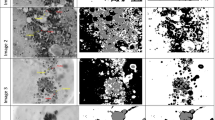Abstract
Histopathology imaging provides high resolution multispectral images for study and diagnosis of various types of cancers. The automatic analysis of these images can greatly facilitate the diagnosis task for pathologists. A primary step in computational histology is accurate image segmentation to detect the number and spatial distribution of cell nuclei in the tissue, along with segmenting other guiding structures such as lumen and epithelial regions which together make up a gland structure. This paper presents a new method for gland structure segmentation and nuclei detection. In the first step, fuzzy c-means with spatial constraint algorithm is applied to detect the potential regions of interest, multiphase vector-based level set algorithm is then used to refine the segmentation. Finally, individual nucleus centers are detected from segmented nuclei clusters using iterative voting algorithm. The obtained results show high performances for nuclei detection compared to the human annotation.
Preview
Unable to display preview. Download preview PDF.
Similar content being viewed by others
References
Doyle, S., Hwang, M., Shah, K., Madabhushi, A., Feldman, M., Tomaszeweski, J.: Automated grading of prostate cancer using architectural and textural image features. In: IEEE International Symposium on Biomedical Imaging: From Nano to Macro ISBI 2007, pp. 1284–1287 (April 2007)
Naik, S., Doyle, S., Feldman, M., Tomaszewski, J., Madabhushi, A.: Gland segmentation and computerized gleason grading of prostate histology by integrating low-, high-level and domain specific information. In: Proceedings of MIAAB, Piscataway, NJ, USA (2007)
Hafiane, A., Zavidovique, B., Chaudhuri, S.: A modified fcm with optimal peano scans for image segmentation. In: IEEE ICIP, Genova, Italy (2005)
Vese, L., Chan, T.: A multiphase level set framework for image segmentation using the Mumford and Shah model. Intern. J. Comput. Vis. 50(3), 271–293 (2002)
Chan, T., Vese, L.: Active contours without edges. IEEE Trans. Image Process. 10(2), 266–277 (2001)
Mumford, D., Shah, J.: Optimal approximations by piecewise smooth functions and associated variational problems. Communication on Pure and Applied Mathematics 42, 577–685 (1989)
Dufour, A., Shinin, V., Tajbakhsh, S., Guillén-Aghion, N., Olivo-Marin, J.-C., Zimmer, C.: Segmenting and tracking fluorescent cells in dynamic 3-D microscopy with coupled active surfaces. IEEE Trans. Image Process. 14(9), 1396–1410 (2005)
Yan, P., Zhou, X., Shah, M., Wong, S.: Automatic segmentation of high-throughput rnai fluorescent cellular images. IEEE Trans. on Information Technology in Biomedecine 12(1) (January 2008)
Caselles, V., Kimmel, R., Sapiro, G.: Geodesic active contours. Int. J. Comput. Vis. 22(1), 61–79 (1997)
Bunyak, F., Palaniappan, K., Nath, S.K., Seetharaman, G.: Flux tensor constrained geodesic active contours with sensor fusion for persistent object tracking. Journal of Multimedia 2(4), 20–33 (2007)
Chan, T., Sandberg, B., Vese, L.: Active contours without edges for vector-valued images. J. of Visual Communication and Image Representation 11, 130–141 (2000)
Gevers, T., Weijer, J., Stokman, H.: Color feature detection. In: Lukac, R., Plataniotis, K.N. (eds.) Color Image Processing: Methods and Applications. CRC Press, Boca Raton (2006)
Parvin, B., Yang, Q., Han, J., Chang, H., Rydberg, B., Barcellos-Hoff, M.H.: Iterative voting for inference of structural saliency and characterization of subcellular events. IEEE Transactions on Image Processing 16(3), 615–623 (2007)
Schmitt, O., Hasse, M.: Radial symmetries based decomposition of cell clusters in binary and gray level images. Pattern Recognition 41, 1905–1923 (2008)
Author information
Authors and Affiliations
Editor information
Editors and Affiliations
Rights and permissions
Copyright information
© 2008 Springer-Verlag Berlin Heidelberg
About this paper
Cite this paper
Hafiane, A., Bunyak, F., Palaniappan, K. (2008). Fuzzy Clustering and Active Contours for Histopathology Image Segmentation and Nuclei Detection. In: Blanc-Talon, J., Bourennane, S., Philips, W., Popescu, D., Scheunders, P. (eds) Advanced Concepts for Intelligent Vision Systems. ACIVS 2008. Lecture Notes in Computer Science, vol 5259. Springer, Berlin, Heidelberg. https://doi.org/10.1007/978-3-540-88458-3_82
Download citation
DOI: https://doi.org/10.1007/978-3-540-88458-3_82
Publisher Name: Springer, Berlin, Heidelberg
Print ISBN: 978-3-540-88457-6
Online ISBN: 978-3-540-88458-3
eBook Packages: Computer ScienceComputer Science (R0)




